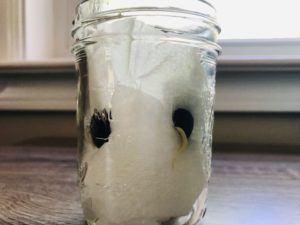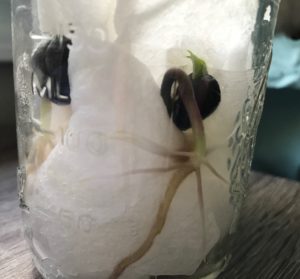
Callie’s Beans Sprouting.
Welcome to week three of the #SproutChallenge! In this lesson we will explore the fascinating history of beans. Beans are edible seeds that have been cultivated for thousands of years. Callie Bennet, assistant educator at the McClung, joined the #SpoutChallenge and planted dry black beans she had in her pantry. Callie documents the emergence of a radicle, the embryonic root or beginnings of the plant, on the third day of her project and the development of leaves by Day 5.
The black bean that Callie is sprouting is part of a larger group of beans known as the common bean, Phaseolus vulgaris. The common bean belongs to the botanical family of legumes in which plants grow seeds in pods. The dry seed from a pod is called a pulse. If you’ve ever had peas, peanuts, lentils, or soybeans you’ve eaten a legume!
An interesting attribute of legumes is that they are nitrogen fixers. All plants need nutrients such as nitrogen, phosphorus, and potassium to develop properly. Legumes enrich the soil in which they grow by fixing substantial quantities of nitrogen and, in the process, contribute to their own growth as well as that of the plants around them. As a result, beans, for example, are frequently sewn with other crops such as maize and squash.

Callie’s Black Beans.
The Phaseolus vulgaris species includes many familiar varieties such as green beans, kidney beans, and pinto beans among many others. These beans are excellent sources of protein and fiber, and are also good sources of magnesium, iron, and zinc. Beans not only pack a nutritional punch to our diets, they are also budget friendly and can be adapted for long-term storage in your pantry– up to 7 months under optimal conditions. Considering beans’ flavor and nutritional value, it is no wonder that they are a preferred ingredient in traditional dishes around the world!
Archaeological evidence and Native American oral histories like the Three Sisters support the influential legacy of beans. Genetic research of archaeological and modern bean samples indicates that the common bean we enjoy today has not one, but two distinct origins: people in both Mesoamerica and the Andes independently domesticated the common bean at different points in time. From there, archaeologists, using advanced technologies on charred bean remains, have traced the arrival of the common bean into Eastern North America sometime around AD 1100, likely along trade routes. Native people in Tennessee started planting beans with their other crops – including corn and squash – shortly after AD 1300. You can read more about the museum’s research into bean domestication here.
Next time you enjoy a meal with beans, remember that they are part of a long agricultural history!